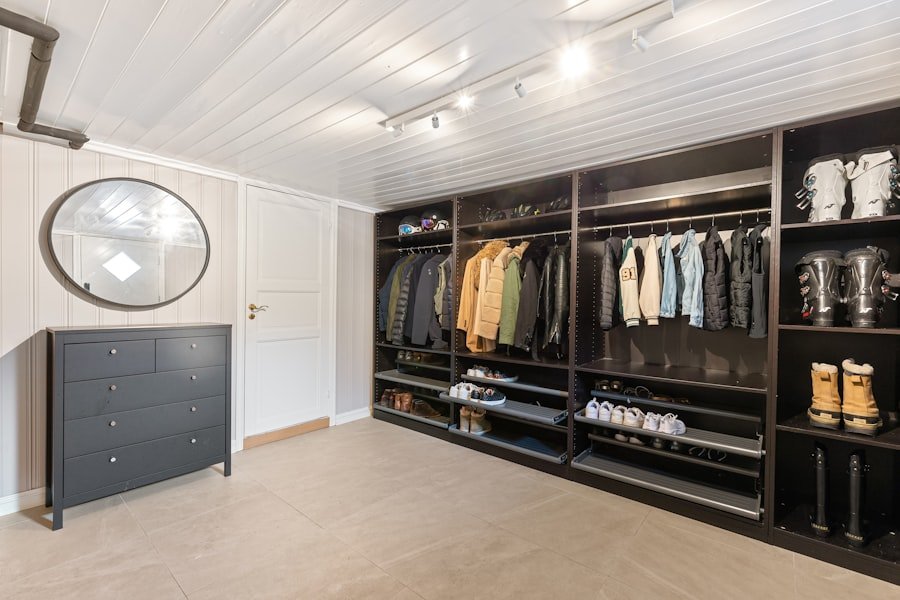In an age where consumerism reigns supreme, the accumulation of possessions can often lead to overwhelming clutter in our homes. Decluttering is not merely a trend; it is a vital practice that can significantly enhance the quality of our lives. A cluttered environment can contribute to stress, anxiety, and a sense of chaos, making it difficult to focus and relax.
When our living spaces are filled with unnecessary items, it can create a mental fog that hampers productivity and creativity. By decluttering, we create a sanctuary that promotes peace and clarity, allowing us to thrive in our personal and professional lives. Moreover, decluttering can have practical benefits that extend beyond aesthetics.
A well-organized home can improve functionality, making it easier to find what you need when you need it. This efficiency can save time and reduce frustration, leading to a more harmonious daily routine. Additionally, decluttering can foster a sense of accomplishment and control over one’s environment, which is particularly important in times of uncertainty.
By taking charge of our spaces, we not only enhance our physical surroundings but also cultivate a mindset geared towards simplicity and intentionality.
Assessing Your Space: Where to Start
Before diving into the decluttering process, it is essential to assess your space thoughtfully. Begin by taking a comprehensive inventory of your home. Walk through each room and take note of areas that feel particularly cluttered or disorganized.
This initial assessment will help you identify specific problem areas and prioritize where to start. It may be beneficial to focus on one room at a time or even break down larger spaces into smaller sections. For instance, instead of tackling an entire bedroom, you might choose to start with the closet or the nightstand.
Another effective strategy is to consider the functionality of each space. Ask yourself how each room is used and whether the items within it serve a purpose. Are there items that have not been used in months or even years?
Are there duplicates that can be eliminated? By evaluating the utility of your possessions, you can make informed decisions about what to keep and what to let go. This process not only clarifies your goals for decluttering but also sets the stage for a more organized and purposeful living environment.
Sorting and Organizing: Tips for Tackling Each Room

Once you have assessed your space, the next step is sorting and organizing your belongings. A systematic approach can make this process more manageable and less overwhelming. One effective method is to use the “Four-Box Method,” where you designate four boxes labeled “Keep,” “Donate,” “Sell,” and “Trash.” As you go through each item, place it in the appropriate box based on its value and utility in your life.
This method encourages decisive action and helps prevent second-guessing. When tackling specific rooms, consider the unique challenges they present. In the kitchen, for example, focus on decluttering countertops and cabinets.
Remove expired food items from the pantry and assess kitchen gadgets that may no longer serve a purpose. In the living room, evaluate bookshelves and entertainment centers for items that can be donated or discarded. Bedrooms often accumulate clothing that may no longer fit or be worn; take this opportunity to assess your wardrobe critically.
By addressing each room with intention and purpose, you can create a cohesive plan that leads to a more organized home.
Decluttering Techniques: KonMari, Minimalism, and More
| Technique | Key Principles | Benefits |
|---|---|---|
| KonMari Method | Keep items that spark joy, discard the rest | Increased sense of joy and clarity, organized living space |
| Minimalism | Focus on essentials, remove excess possessions | Reduced stress, increased focus on experiences over material possessions |
| Feng Shui | Arrange space to promote positive energy flow | Improved energy and harmony in living environment |
Several popular decluttering techniques can guide you through the process, each with its own philosophy and approach. The KonMari Method, developed by Marie Kondo, emphasizes the importance of keeping only those items that “spark joy.” This technique encourages individuals to hold each item in their hands and assess its emotional value before deciding whether to keep it. The KonMari Method also advocates for decluttering by category rather than by room, which can lead to a more comprehensive understanding of what you own.
Minimalism is another approach that has gained traction in recent years. This philosophy encourages individuals to simplify their lives by reducing possessions to only what is necessary or meaningful. Minimalists often focus on quality over quantity, investing in fewer but higher-quality items that serve multiple purposes.
This approach not only reduces clutter but also promotes a lifestyle centered around experiences rather than material possessions. By exploring these techniques and finding one that resonates with you, you can tailor your decluttering journey to align with your values and lifestyle.
Storage Solutions: Making the Most of Your Space
As you declutter, it’s essential to consider how best to utilize the space you have left. Effective storage solutions can transform even the smallest areas into functional spaces. Start by investing in versatile storage options such as baskets, bins, and shelving units that can help organize items while maintaining accessibility.
For instance, under-bed storage containers can be an excellent way to maximize space in bedrooms while keeping seasonal clothing or extra linens out of sight. Vertical storage is another effective strategy for optimizing space. Wall-mounted shelves or hooks can free up floor space while providing easy access to frequently used items.
In kitchens, consider using magnetic strips for knives or hanging pots and pans from ceiling hooks to create an open feel while keeping essentials within reach. By implementing creative storage solutions tailored to your home’s layout, you can maintain an organized environment that supports your lifestyle.
Selling, Donating, or Recycling: What to Do with Unwanted Items

Once you have sorted through your belongings and identified items to part with, it’s crucial to determine the best course of action for these unwanted possessions. Selling items online through platforms like eBay, Facebook Marketplace, or Poshmark can be an effective way to earn some extra cash while giving your items a new life. For larger items such as furniture or appliances, local classifieds or community groups may provide opportunities for quick sales.
Donating is another excellent option for unwanted items that are still in good condition. Charities such as Goodwill or Habitat for Humanity often welcome donations of clothing, household goods, and furniture. Not only does this help those in need, but it also contributes positively to your community.
Recycling should be considered for items that are no longer usable; many municipalities offer recycling programs for electronics, paper products, and plastics. By thoughtfully disposing of unwanted items, you contribute to sustainability efforts while decluttering your home.
Maintenance: How to Keep Your Home Clutter-Free
Decluttering is not a one-time event but rather an ongoing process that requires regular maintenance to keep your home organized and clutter-free. Establishing routines can help ensure that clutter does not accumulate again after your initial efforts. One effective strategy is the “one-in-one-out” rule: for every new item you bring into your home, commit to removing one item.
This practice encourages mindful consumption and helps maintain balance in your living space. Additionally, setting aside time each week or month for quick decluttering sessions can prevent clutter from building up over time. Create designated spaces for frequently used items so they have a home and are easy to return after use.
Encourage family members or housemates to participate in maintaining an organized environment by establishing shared expectations around cleanliness and organization. By fostering a culture of tidiness within your home, you create an atmosphere that supports ongoing decluttering efforts.
Benefits of a Decluttered Home: Improved Mental and Emotional Well-Being
The benefits of decluttering extend far beyond physical space; they encompass mental and emotional well-being as well. A decluttered home can lead to reduced stress levels as individuals find it easier to navigate their environments without distractions or chaos. Studies have shown that clutter can negatively impact focus and productivity; thus, creating an organized space allows for greater concentration on tasks at hand.
Moreover, a clean and organized home fosters a sense of accomplishment and control over one’s environment. This feeling of empowerment can translate into other areas of life, encouraging individuals to pursue goals with renewed vigor and clarity. The act of decluttering itself can be therapeutic; it provides an opportunity for self-reflection as individuals assess their values and priorities through their possessions.
Ultimately, embracing a decluttered lifestyle cultivates not only a more serene living space but also enhances overall mental health and emotional resilience.
FAQs
What is decluttering?
Decluttering is the process of removing unnecessary items from your home in order to create a more organized and functional living space.
Why is decluttering important?
Decluttering is important because it can help reduce stress, improve productivity, and create a more peaceful and enjoyable living environment.
How can I declutter my home in a weekend?
To declutter your home in a weekend, start by setting specific goals, such as decluttering one room at a time. Sort items into categories such as keep, donate, and discard, and then tackle each category one at a time. Set a timer to stay focused and take regular breaks to avoid burnout.
What are some tips for decluttering quickly?
Some tips for decluttering quickly include starting with the easiest areas first, using storage solutions to organize items, and enlisting the help of family or friends to make the process more efficient.
What should I do with items I no longer want?
Items you no longer want can be donated to charity, sold online or at a garage sale, or recycled if possible. It’s important to dispose of items responsibly and consider the environmental impact of your choices.
How can I maintain a clutter-free home after decluttering?
To maintain a clutter-free home, make a habit of regularly decluttering and organizing your belongings. Avoid bringing unnecessary items into your home, and consider implementing a “one in, one out” rule for new purchases.



